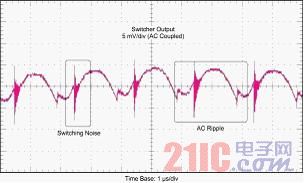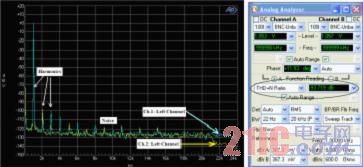Summary
This article refers to the address: http://
A digital-to-analog audio converter (Audio DAC) is a device that converts digital audio encoding into analog audio sounds (eg, music, etc.). During any digital audio encoding conversion, external noise coupling into the audio converter device can have a dramatic impact on the audio band. AC ripple and switching noise, such as DAC power supplies, are one of the main root causes of the degradation in the quality of the converted audio sound. Therefore, the design of high performance digital to analog audio systems requires the audio DAC to be isolated from the power rail noise. In this article, an integrated solution that combines the high efficiency of a switched-mode power supply with the ultra-low noise characteristics of a linear power supply solves this problem, providing higher audio quality.
introduction
Most modern audio is stored in digital format, such as Pulse Code Modulation (PCM) and MP3. It provides lossless data storage, high-quality, perfect copying, indefinite storage, high flexibility, and compatibility with other digital systems. An audio DAC is required to convert these digital formats into analog signals that drive the speakers to produce audio sounds (analog waves). The audio amplifier amplifies the converted audio sound and the speaker transmits it to the listener.
It is generally believed that the analog audio sound that will be transmitted to the listener is the final output of the audio system. Its quality depends on the entire audio system, including the original digital encoding itself, the audio DAC device, the audio power amplifier and the quality of the speakers or headphones.
If we focus on the audio DAC, the performance depends on the quality of the DAC itself and is affected by other external factors. High performance audio DACs are sensitive to external noise. These external noises enter the audio band during the conversion. This noise can come from AC power ripple, RF interference, switching noise, and even thermal noise from other circuit components in the audio system. This article will explore how to ultimately improve the noise performance of an audio converter by increasing the noise performance of the DAC supply voltage.
Audio performance specification
In order to quantify the noise performance of a sound system, we need to determine certain specification parameters. Total Harmonic Distortion (THD) Determines the number of bad signals produced by the audio converter during playback of the audio signal. Systems such as audio converters are non-ideal and non-linear devices with single or multiple inputs and outputs. They always have distortion of the original input signal. This distortion is often added to the harmonics of the original input signal. Therefore, total harmonic distortion represents the amount of distortion of the original signal and is an ideal technical parameter to measure the performance of all audio DACs.
However, the total harmonic distortion alone does not include other non-distortion related noise that the DAC produces an output signal. Therefore, by combining total harmonic distortion with noise, another measurement standard, the THD+N specification, can be constructed. THD+N accurately quantifies all noise generated by the DAC that is independent of the input signal. This noise comes from power supply AC ripple, RF interference, switching noise, vibration, and thermal components of the audio components of the audio system.
The THD+N specification is often used to specify the performance of an audio DAC device, but it does not delve into the performance of the DAC in the band. An FFT analyzer map is required to analyze the quality of all analog audio signals in its frequency band. This type of analyzer utilizes the time to change the analog audio output signal and converts it into a spectrum by Fast Fourier Transform (FFT). This measurement shows the audio converter performance of an audio converter over its entire 1 – 20 KHz range and clearly shows noise and harmonic distortion performance.
The impact of power on audio performance
Most audio applications are powered by a 12V bus AC power adapter. We must convert this 12V bus to 5V or 3.3V to meet the requirements of the audio DAC converter. We can do this with a switched or linear regulator. Switching regulators are ideal because they have higher efficiency. They are typically 80%-95% efficient, minimizing system power consumption and heat generation. However, these regulators have switching noise and have an AC ripple voltage above their DC output voltage. These two effects reduce the performance of the audio DAC. Figure 1 shows the typical output voltage of a switching converter.

Figure 1. Typical output voltage ripple of the converter
The higher the AC ripple and noise of the power supply, the greater the adverse effect it has on the sound quality. Input noise and ripple can enter the IC itself and can affect performance by interfering with audio during the conversion process, interfering with internal bias, clocks, oscillators, and more. They can also be coupled to the output through a board layout. In addition, the performance of the overall audio system, including power audio amplifiers and speakers, is affected. Therefore, power supply noise can greatly degrade the quality of the output audio sound.
The example in Figure 2 shows the final performance of an audio DAC (eg PCM5102) powered directly by a 3.3V switching regulator. The test is performed by applying a standard 1-kHz test tone to the digital input of the DAC. The measurement is performed using an audio precision (AP) analyzer test device. In this example, the FFT plot of the analog audio output signal indicates a difference between the left and right channels because the noise floor of the two channels is different. The THD+N results show that a noisy power supply greatly reduces the quality of the output audio signal.

Figure 2 FFT spectrum analysis and THD+N measurement of a sine wave audio signal powered by a converter
Isolating switching noise and ripple from the power rail of the DAC for higher audio performance. Adding additional filtering to the converter output can help reduce some noise. However, some precision filters are too luxurious, complex, and take up more space. In addition, most filters have power and load regulation issues and poor transient response. Converting a 12V input bus to 3.3V with a linear regulator (LDO) can greatly reduce ripple and noise for higher audio performance. The disadvantage of using LDOs is that the design is less efficient and consumes more power.
Figure 3 shows an FFT plot of an audio DAC powered by an LDO. As with the previous test, we applied a 1-KHz sinusoidal audio signal to the light input of the DAC. The test conditions are the same as before, and the same audio accuracy test equipment is used as the measurement tool to obtain the following FFT results and THD+N measurement.

Figure 3. FFT plot spectrum analysis and THD+N measurement results for a sine wave audio signal audio DAC powered by an LDO
Using LDO low noise power rails can improve sound quality by approximately 8 dB. Figure 3 shows that THD+N will exceed 93 dB. In addition, after observing the FFT spectrum analyzer diagram, we found that the noise floor was greatly reduced. Harmonics are easily identifiable depending on the performance of the device. In most of its frequency bandwidth, this noise floor is maintained below –120 dBV compared to –110 dBV (see Figure 2). This result demonstrates that using a low noise power rail on the audio converter can improve performance.
Compared to converters, LDO power solutions have a much lower noise output voltage, but linear regulators are less efficient and can cause thermal issues in the system. Therefore, the ideal solution is to combine the high efficiency of the converter with the low noise output of the linear regulator to achieve an efficient, low noise power solution. However, in applications where both of these factors are important, there are often price and space constraints.
In the integrated switching converter and LDO regulator, we will find an integrated converter + LDO solution, such as: TPS54120. 1A switching converter combined with LDO, can effectively provide low noise power to the audio converter . In addition, this integrated solution is a low-cost solution that takes up less board space. Its excellent load and line-voltage transient response allows it to withstand a wide input voltage range when using a small package, making it ideal for home audio applications.
A more low-noise output voltage can be obtained by using an integrated switching converter and LDO regulator instead of the converter of the first measurement example (see Figure 4). We did not observe output voltage noise or ripple. Apply a 12V input voltage and adjust the output to 3.3V. The measured output voltage is measured at 400 mA load current. This voltage perfectly drives the entire audio system without worrying about the converter's noise and AC ripple.

Figure 4 Output Voltage Ripple of Integrated Converter and LDO Regulator
In Figure 5, an integrated transfer switch and LDO regulator are used to power the audio DAC. The regulator input uses a 12 volt input voltage. We get the same results as in Figure 3.

Figure 5 Schematic diagram of an integrated converter and LDO regulator-powered audio DAC
Table 1 compares the cost, board space, efficiency, and performance of different solutions. We have found that the integrated solution of converter + LDO has the advantages of high performance and high efficiency.
Table 1 Comparison of different solutions

in conclusion
The AC ripple and switching noise generated by the switched-mode power supply can have a negative effect, which reduces the quality of the audio DAC output. We can use some filtering techniques to isolate the audio converter from these noise sources. In addition to noise, the efficiency and cost of the filter, as well as the board space occupied in the audio system, are important factors. Combining the high efficiency of a switching converter with the ultra-low noise performance of an LDO is an ideal solution. In addition, switching converter + LDO integrated solutions have advantages over stand-alone solutions due to further cost and board space footprint.
Fast charging,Fast heat radiation,longer life,safety and stability.
Raw materials:
-100% pure lithium cobalt oxide core, high-density ceramic diaphragm, Ensure capacity density same with original 1: 1.
-Load IC from IBM manufacturer can received excessive current meanwhile not automatic shut off.
-TI
IC is Apple original battery chip supplier, the main control chip
automatic updated with original iOS system operation data. Ensure
stability without worrying about power diving. Ensure normal battery
loss, automatic identification with the original battery to maintain the
same performance, intelligent identification, intelligent operation, no
blue screen.
-OEM order connector, high precision, to ensure stable connection with mobile phones, accurate reading data.
*Related Products:
iPhone Li-ion Battery TI IC,iPhone Replacement Battery TI IC,iPhone Battery TI IC,iPhone Replacement
Shenzhen Aokal Technology Co., Ltd. , https://www.aokal.com